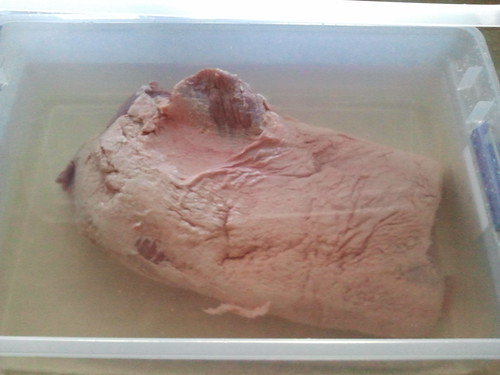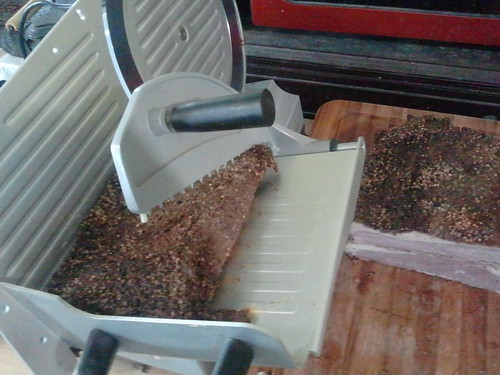Geez, have you priced pastrami at the deli lately? Nine bucks a pound! Also, I happen to like my pastrami with some fat on it like they used to make when I was a kid, and that stuff is getting harder to find these days.
Here's a quick primer about pastrami. Take a look at the beef cuts chart below. The parts we want to pay particular attention to are the plate, the brisket, and the round:
 |
| Illustration courtesy Wikipedia Commons / Ysangkok |
In my youth, Plate Pastrami was common. As you can probably figure out, it's made from beef plate, the fatty "belly" area of the beefer which is also the source of short ribs. Plate pastrami gets a lot of it's textural character and richness from the fat which is integral to the cut. It closely resembles bacon, which shouldn't be surprising. Bacon is cured and smoked pig belly, and plate pastrami is cured and smoked beef belly. Plate pastrami is hard to find these days; most supermarkets and delis don't carry it, and if you want to make your own the plate cut often has to be special ordered from a trusted butcher. This rarity is market-driven - while once upon a time, consumers wanted flavorful fatty meat, they are now demanding leaner cuts, and there is no way anyone can describe the plate as "lean."
This is why so much pastrami sold nowadays is Round Pastrami. It's made from the round of the beef, which is very lean. It's very popular and has all but replaced plate pastrami in supermarkets and most delis, but I don't find it at all desireable - pastrami should have some fat on it!
And so, without ready access to beef plate and without any interest at all in curing a round, I direct your attention to the brisket, the cut just in front of the plate. Brisket Pastrami doesn't have quite as much fat as a proper plate pastrami, but it's not bad. It's actually a pretty good compromise between the very fatty plate and the very lean round. And because briskets are pretty easy to come by, you can make pastrami just about any time you want.
Making the Pastrami
Pastrami starts out as a brine-cured cut of meat - a corned beef, actually. There are many perfectly acceptable commercial corned beefs out there, so when I make pastrami at home, I start with a commercial corned beef rather than a fresh brisket. That allows me to skip the curing process and get right to the seasoning and smoking.
So: Start with a commercial corned beef. You can use a flat cut or a point cut as you prefer. (I happened to get a great deal on a whole brisket and decided to turn the entire thing into enough pastrami for family and friends.)
Remove the corned beef from the wrapping, drain off any juices, and rinse it off. You can also use this opportunity to trim some of the fat and membranes off. I remove the membranes, but only minimally trim the fat.
 |
| Notice that this is pretty much an untrimmed brisket. Remember, fat is flavor. |
Place the corned beef into a container and add enough water to cover the pastrami. Let it sit and soak for about twenty-four hours or so. You don't have to change the water - just make sure the meat is covered by the water. The idea is to soak out a lot of the salt that's in the corned beef. As the beef cooks over the smoke and turns into pastrami, it can lose up to 20% of its weight, which will concentrate any salt remaining in the meat. Without this soaking step, your finished pastrami will be almost unbearably salty.
The next day, make up a batch of Pastrami Rub. The most basic of pastrami rubs contain black pepper and coriander with a touch of paprika. Over time, I've developed a rub that gives me exactly the flavor I'm looking for, and that's the recipe I'm sharing here. I encourage you to do some experimenting, too, so you can find your own perfect blend.
Pastrami Rub
Makes enough to transform 1 average point cut or flat cut corned beef into pastrami. If you're using a whole brisket, double the recipe.
1/4 cup black peppercorns
1/4 cup coriander seed
1 tablespoon white pepper
2 tablespoons yellow mustard seed
2 tablespoons good paprika
1/4 cup kosher salt
Grind the peppercorns, coriander, and mustard seed coarsely in a spice grinder or use a mortar and pestle. Add the paprika (use a good quality Hungarian paprika if you can, not that nasty red dust they sell in dollar stores in plastic tubes) and salt, stir well to thoroughly combine.
Take the brisket out of it's soaking water and pat it dry as best you can. Rub the spices liberally onto every square inch of the brisket's surface, pressing the mixture into the surface as you go so there is a decent coating of spices.
With the beef well-coated, put it into the smoker and hold it over the smoke at 250 F for three or four hours, or until the internal temperature of the brisket reaches 165 F on a meat thermometer inserted into the thickest part of the meat. I like to use a mild wood for the smoke - apple is good, and so is citrus wood and maple.
Take the brisket out of the smoker, wrap it up well in aluminum foil, and chill it thoroughly. Cold meat slices better than hot.
The next day, make up a batch of Pastrami Rub. The most basic of pastrami rubs contain black pepper and coriander with a touch of paprika. Over time, I've developed a rub that gives me exactly the flavor I'm looking for, and that's the recipe I'm sharing here. I encourage you to do some experimenting, too, so you can find your own perfect blend.
Pastrami Rub
Makes enough to transform 1 average point cut or flat cut corned beef into pastrami. If you're using a whole brisket, double the recipe.
1/4 cup black peppercorns
1/4 cup coriander seed
1 tablespoon white pepper
2 tablespoons yellow mustard seed
2 tablespoons good paprika
1/4 cup kosher salt
Grind the peppercorns, coriander, and mustard seed coarsely in a spice grinder or use a mortar and pestle. Add the paprika (use a good quality Hungarian paprika if you can, not that nasty red dust they sell in dollar stores in plastic tubes) and salt, stir well to thoroughly combine.
Take the brisket out of it's soaking water and pat it dry as best you can. Rub the spices liberally onto every square inch of the brisket's surface, pressing the mixture into the surface as you go so there is a decent coating of spices.
With the beef well-coated, put it into the smoker and hold it over the smoke at 250 F for three or four hours, or until the internal temperature of the brisket reaches 165 F on a meat thermometer inserted into the thickest part of the meat. I like to use a mild wood for the smoke - apple is good, and so is citrus wood and maple.
Take the brisket out of the smoker, wrap it up well in aluminum foil, and chill it thoroughly. Cold meat slices better than hot.
When the meat is cold, slice it as thinly as possible. I have a meat slicer, but if you don't, that's okay - use a good sharp slicing knife and make thin, uniform slices against the grain.
Check that out - isn't it just gorgeous?
You can eat it just the way it is if you like - remember, it is fully cooked - but you can also sizzle it a bit in a frying pan or, if you've trimmed a lot of the fat off it first, steam it. Get yourself some good rye bread, some sharp mustard, and some strong horseradish if you so desire, and have yourself a feast.
Check that out - isn't it just gorgeous?
You can eat it just the way it is if you like - remember, it is fully cooked - but you can also sizzle it a bit in a frying pan or, if you've trimmed a lot of the fat off it first, steam it. Get yourself some good rye bread, some sharp mustard, and some strong horseradish if you so desire, and have yourself a feast.



9 comments:
Awesome post!
My life is better now.
I am going to do this, and have myself a feast.
And never, ever, not in this lifetime think that turkey pastrami can pass for real pastrami.
It ain't bad for some things. But, it ain't pastrami.
Great post! Will definitely be doing this. Since you mentioned it - any recommendations on good meat slicers?
Looking for beef plate in all the right places today. We have some upscale Mexican markets nearby, that had some wonderful pork belly last week. Just now they are hanging to dry. Soaking some chips now, and will begin the smoker later in the day.
I do thank you for your blazing these trails for us. Our at-home bacon has already been described as the best folks have ever had.
John - Cheap slicers are no good, and good slicers are not cheap. I didn't want to spend over a thousand dollars on one at my local restaurant supply place, so I turned to Cabela's and found exceptionally good slicers - close to professional grade - at what I considered to be a reasonable price (the model I bought retails for a little over $400, but it was missing some screws so I was able to get it from their "bargain cave" for considerably less.)
SJBill - Thanks for the compliment. Glad I could help.
Plate pastrami! You are blessed, sir, for this information. Many's the time I've turned away disgustedly from a deli counter, bemoaning the loss of something which I'd tasted only once, as a young lad. (Poppa soon thereafter abandoned food for health. Never again did he make the world's best cheesecake, either.)
I figured that it had something to do with the phenomenon of Jewish WASP-ism. (Curse you, Ralph Lauren!) The truly funny thing is the countless times I've heard my Jewish (male) friends bemoan the state of deli. No wonder! They broke the faith. Now, instead of dying at 60 of a massive coronary, they can all live to die a long, lingering death from cancer. Mazel tov! (I kid because I love.)
Thanks for the recipe & off-line help. I made your pastrami this past weekend, and it was simply outstanding. I hope my blog post conveys my appreciation:
http://adventuresofacuriousfellow.blogspot.com/2013/01/daves-pastrami.html
Tom
I keep meaning to add that one son takes pastrami sandwichs to high school for lunch every time I make your recipe, and everyone thinks it's way cool that his dad makes his own pastrami.
Tom
Post a Comment